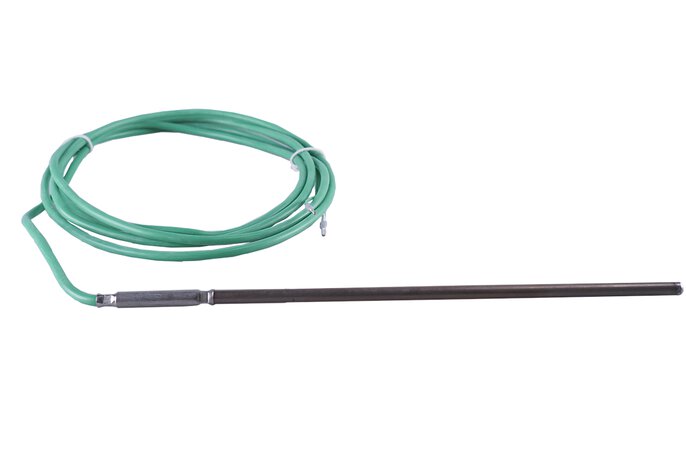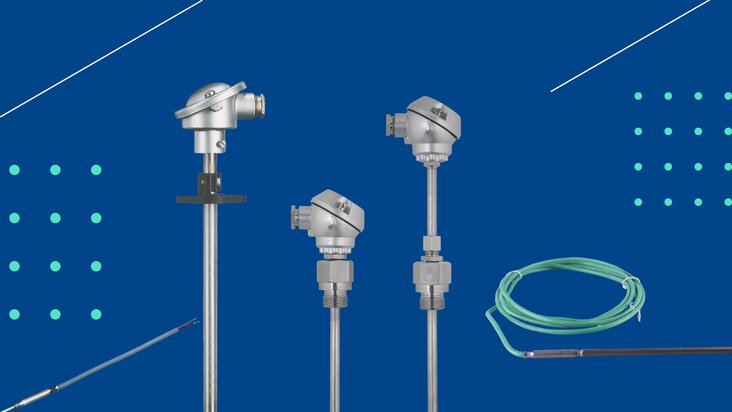

Grounded vs ungrounded thermocouple – which one to choose?
Which thermocouple to choose – grounded or ungrounded? This is one of the most frequently asked questions when buying thermocouple sensors. In this post, we outline the advantages and disadvantages of both solutions and the optimal applications for each. You will also learn what other considerations to take into account when choosing a thermocouple. Check it out!
Thermocouple – principle of operation
The thermocouple (thermoelectric sensor) is one of the most popular temperature measurement sensors used in industry. It works on the principle of the Seebeck phenomenon. This is a thermoelectric phenomenon, whereby an electromotive force is generated in a circuit consisting of at least two different conductors whose junctions are at different temperatures.
What is the basic structure of thermocouple?
Thermocouples are made up of two wires of different metals, welded together at a point called the junction. At the junction, the actual temperature measurement is carried out. The thermocouple wires are protected by a metal sheath.
Thermocouple sensor – applications
Thermocouples are typically used for high-temperature measurement in applications requiring a temperature sensors to respond quickly and resist vibration.

A thermocouple is a temperature sensor made of two different materials, welded together at a point called a junction
Grounded or ungrounded thermocouple – what does this mean?
A thermocouple is grounded when the connector is welded to the sheath at the end of the sensor. In an ungrounded thermocouple, the connector does not touch the sheath.
Grounded thermocouple
Advantages of grounding a thermocouple sensor
A grounded thermocouples transfers heat more efficiently. A connector welded to the sheath responds more quickly to temperature changes because the metal-to-metal contact creates a shorter thermal path compared to an ungrounded thermocouple.
In summary, the biggest advantage is:
-
fast response time
Disadvantages of grounding a thermocouple sensor
However, grounding the thermocouple can also cause an undesirable side effect, called 'ground loop'. How does this phenomenon occur?
When the connector is welded to the sheath, an electrical connection is also created between the wires and the sheath. This can lead to a 'ground loop' when the sensor is connected to a ground at the measurement location and the wires are connected to a grounded controller at another location. The two earths can have different voltage potentials, creating an unwanted circuit and interference that can damage the equipment.
In summary, the main disadvantage is:
-
the possibility of a ground loop
Ungrounded thermocouple probe
An ungrounded thermocouple has a measuring junction not welded to the sheath. Typically, its junction at the tip of the sensor is surrounded by a non-conductive powder such as magnesium oxide. Its purpose is to slow down heat transfer from the medium being measured to the thermocouple junction.
Advantages of an ungrounded thermocouples
Because the thermocouple wire is electrically isolated from the metal sheath and housing, using an ungrounded thermocouple reduces the risk of a ground loop. In addition, the lack of grounding provides greater accuracy in temperature measurement, especially for low-power signals.
In summary, the biggest advantages of an ungrounded thermocouple are:
-
lower risk of ground loops
-
more accurate measurements
Disadvantages of an ungrounded thermocouple
An ungrounded thermocouple has a slower response time.
Application
An ungrounded thermocouple sensor will work well in corrosive environments where it is desirable for the thermocouple to be electronically isolated from and shielded by the sheath.
Ground loop – signs
How do you know if a ground loop has formed? The signs that tell you this can vary, including:
-
increased susceptibility to weather changes
-
unstable readings
-
in some cases the device may stop working
-
in extreme cases, smoke
Wie kann man eine Erdschleife verhindern?
-
Nur eine Masse - entweder der Anschlusskopf oder der Controller/Recorder, aber nicht beides
-
Wenn du einen Sender wählst, der über eine interne Isolierung zwischen Eingang, Ausgang und Masse verfügt, ist die Isolierung in der Regel ausreichend, um die Masseschleife zu beseitigen
-
Isolatoren, die in der Schleifenverdrahtung platziert werden können
Die einzige zuverlässige Möglichkeit, dies zu tun, ist die Verwendung eines ungeerdeten Thermoelementes.
Was ist bei der Wahl eines Thermoelementes noch zu beachten?
-
Anwendung - Bestimme, für welche Anwendung du das Thermoelement brauchst
-
Gemessener Temperaturbereich - dies bestimmt die Art des Thermoelements, z.B. Thermoelemente vom Typ k oder j für hohe Temperaturen oder Thermoelemente vom Typ t am besten für niedrige Temperaturen
-
Installationsanforderungen
-
Konstruktion z.B. Mantel-, Kabelthermoelemente
-
Genauigkeitsklasse
- ${title}${badge}

